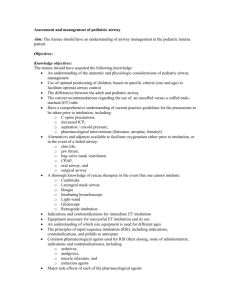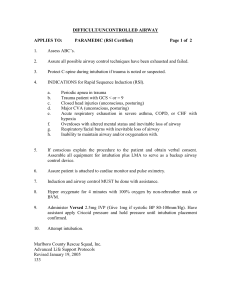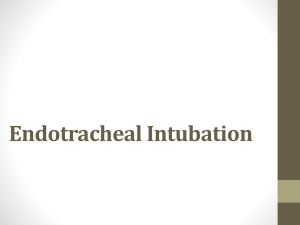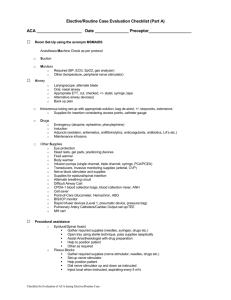Airway Management Study Guide
advertisement
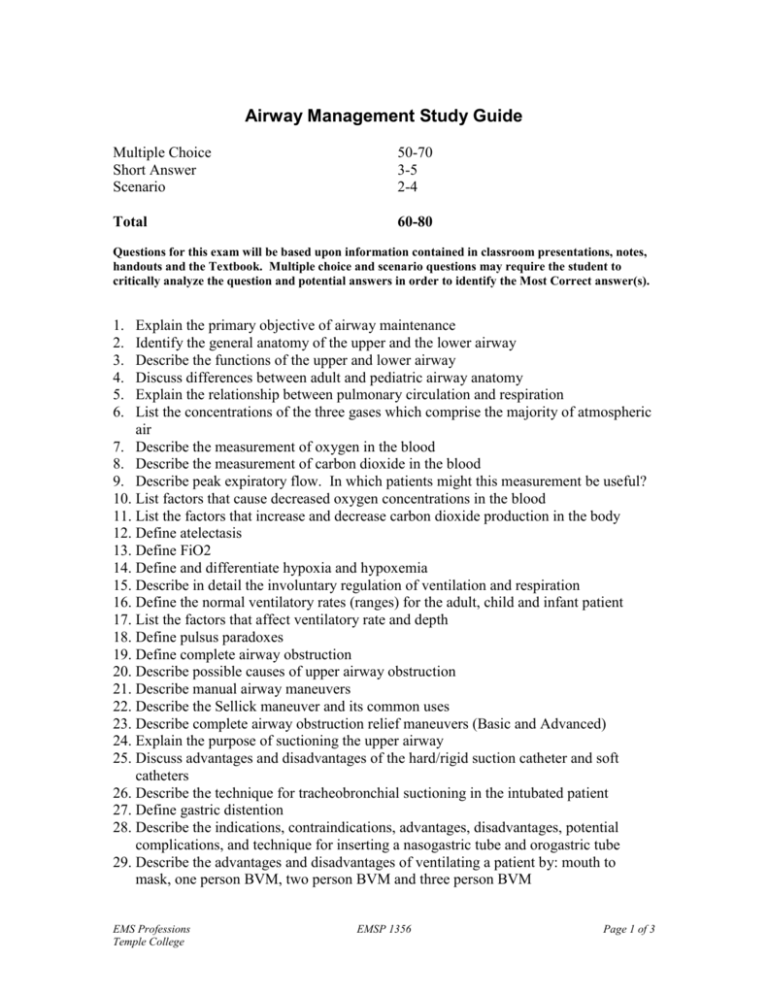
Airway Management Study Guide Multiple Choice Short Answer Scenario 50-70 3-5 2-4 Total 60-80 Questions for this exam will be based upon information contained in classroom presentations, notes, handouts and the Textbook. Multiple choice and scenario questions may require the student to critically analyze the question and potential answers in order to identify the Most Correct answer(s). 1. 2. 3. 4. 5. 6. Explain the primary objective of airway maintenance Identify the general anatomy of the upper and the lower airway Describe the functions of the upper and lower airway Discuss differences between adult and pediatric airway anatomy Explain the relationship between pulmonary circulation and respiration List the concentrations of the three gases which comprise the majority of atmospheric air 7. Describe the measurement of oxygen in the blood 8. Describe the measurement of carbon dioxide in the blood 9. Describe peak expiratory flow. In which patients might this measurement be useful? 10. List factors that cause decreased oxygen concentrations in the blood 11. List the factors that increase and decrease carbon dioxide production in the body 12. Define atelectasis 13. Define FiO2 14. Define and differentiate hypoxia and hypoxemia 15. Describe in detail the involuntary regulation of ventilation and respiration 16. Define the normal ventilatory rates (ranges) for the adult, child and infant patient 17. List the factors that affect ventilatory rate and depth 18. Define pulsus paradoxes 19. Define complete airway obstruction 20. Describe possible causes of upper airway obstruction 21. Describe manual airway maneuvers 22. Describe the Sellick maneuver and its common uses 23. Describe complete airway obstruction relief maneuvers (Basic and Advanced) 24. Explain the purpose of suctioning the upper airway 25. Discuss advantages and disadvantages of the hard/rigid suction catheter and soft catheters 26. Describe the technique for tracheobronchial suctioning in the intubated patient 27. Define gastric distention 28. Describe the indications, contraindications, advantages, disadvantages, potential complications, and technique for inserting a nasogastric tube and orogastric tube 29. Describe the advantages and disadvantages of ventilating a patient by: mouth to mask, one person BVM, two person BVM and three person BVM EMS Professions Temple College EMSP 1356 Page 1 of 3 Airway Management Study Guide 30. Describe the indications, contraindications, advantages, disadvantages, and potential complications for using an automatic transport ventilator 31. Explain safety considerations of oxygen storage and delivery 32. Describe the use, advantages and disadvantages of an oxygen humidifier 33. Define and describe a tracheostomy, stoma and tracheostomy tube 34. Define and describe a laryngectomy 35. Discuss how to ventilate a patient with a stoma including mouth to stoma and BVM to stoma ventilation 36. Differentiate endotracheal intubation from other methods of advanced airway management 37. Describe how the paramedic could use laryngoscopy for the removal of a foreign body airway obstruction 38. Describe indications, contraindications, advantages, disadvantages, complications, equipment and the technique for direct laryngoscopy 39. Discuss the use of cricoid pressure during intubation. What is the other name for this technique? 40. Describe the visual landmarks used when performing direct laryngoscopy 41. Describe the indications, contraindications, advantages, disadvantages, complications, technique, and equipment for using a dual lumen airway. When discussing technique and equipment, use the combitube and LMA as your examples. 42. Describe the indications, contraindications, advantages, disadvantages, complications, and equipment for rapid sequence intubation using sedation & neuromuscular blocking agents 43. Identify neuromuscular blocking agents and other agents commonly used in rapid sequence intubation 44. Identify sedative and induction agents used in airway management 45. Describe the indications, contraindications, advantages, disadvantages, complications, and equipment for nasotracheal intubation 46. Describe the indications, contraindications, advantages, disadvantages, complications, and equipment for performing a surgical cricothyrotomy 47. Describe the equipment and technique for performing a surgical cricothyrotomy 48. Describe the indications, contraindications, advantages, disadvantages, complications, and equipment for translaryngeal catheter ventilation (needle cricothyrotomy) 49. Describe at least 3 methods of assessment for confirming correct placement of an endotracheal tube 50. Describe methods for securing an endotracheal tube and for minimizing the risk of accidental dislodgment 51. Describe the indications, contraindications, advantages, disadvantages, complications, and equipment for endotracheal tube extubation 52. Describe differences in endotracheal intubation for the pediatric patient 53. Discuss differences in anatomy by comparing the adult airway to the pediatric airway 54. Describe the indications, contraindications, advantages, disadvantages, complications, and equipment for needle decompression of a tension pneumothorax 55. Discuss the signs and symptoms of tension pneumothorax 56. Describe the indications, contraindications, advantages, disadvantages, complications, and equipment for placement of a gastric tube to relieve gastric distention EMS Professions Temple College EMSP 1356 Page 2 of 3 Airway Management Study Guide 57. Briefly discuss how one could identify an appropriately sized gastric tube for nasogastric intubation 58. List the appropriate sizes of endotracheal tubes for a typical adult male and female 59. Describe methods useful in determining the appropriate sizes of endotracheal tubes for a pediatric patient 60. List the appropriate size of endotracheal tube given a patient in the age groups of: premature, newborn, 1 year, and 2-8 years of age 61. Discuss the appropriate depth of insertion for the endotracheal tube in an adult 62. Discuss a method of determining the appropriate depth of insertion for the endotracheal tube in a pediatric patient 63. Discuss why laryngoscopy is used and how it relates to the alignment of the planes of view for vocal cord visualization 64. Discuss methods used to recognize patients who may be candidates for difficult intubation 65. Discuss the differences in the use of the curved vs the straight laryngoscope blades 66. Discuss the steps used in the technique of digital intubation 67. Discuss the indications and technique of performing a chest escharotomy 68. Discuss the potential hazards and infectious disease risks encountered by the paramedic during a variety of advanced airway management techniques EMS Professions Temple College EMSP 1356 Page 3 of 3
